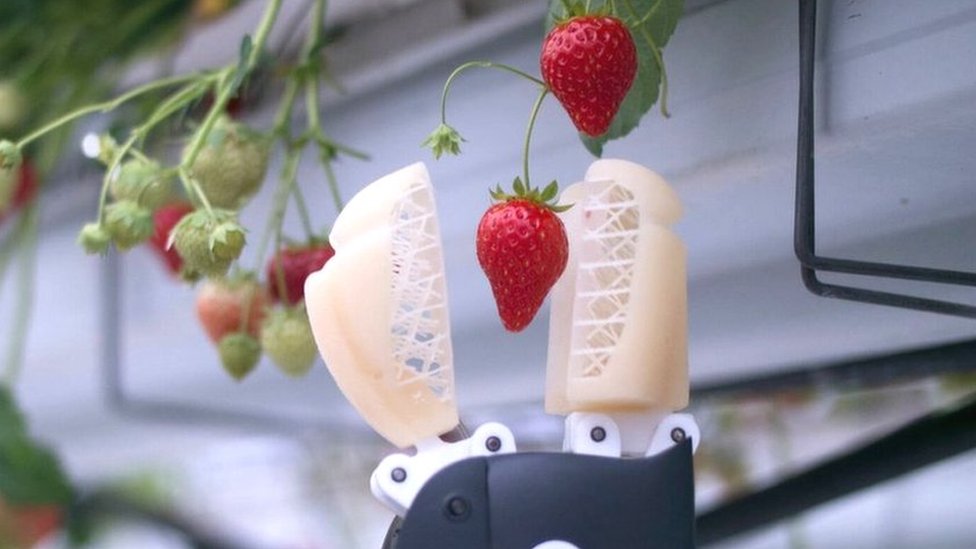INSUBCONTINENT EXCLUSIVE:
Media captionCome strawberry-picking with robotsWith strawberry picking season well under way - but migrant labour in short supply in
several countries - we look at the various robots being developed around the world to help producers harvest this most popular fruit
Next time you buy strawberries take a look a good look in the punnet
Do the berries still have the stem attached or has it been plucked off leaving only the green hat of leaves called the calyxYou may not
think that matters, but it's a key consideration for growers as they contemplate the merits of a range of robotic prototypes that promise
to pick strawberries as fast and as carefully as humans.Whether the berry is plucked or whether the stalk is snipped through and kept
attached is one critical difference between the concepts that Spanish, Belgian, British and US engineers are testing, ready to roll out in
fields as soon as next year
Fragile fruitsHarvesting soft fruit mechanically represents a huge challenge - each berry needs to be located, even if it's behind a leaf,
assessed for ripeness and then harvested and boxed with enormous care to avoid bruising.But recent developments in visual sensor technology,
machine learning and autonomous propulsion have brought the goal within reach."If you can put a man on the moon you can get a machine to
pick a strawberry," says Tom Coen, founder of Octinion, a Belgium-based start-up conducting a final phase of field trials this summer in
partnership with growers in the UK and continental Europe.Image copyrightOctinionImage caption
Octinion's robotic arm
gently grasps the strawberry, snaps it off, and drops it in the punnet
"Today we can say we have a [robotic] arm that is
competitive with a human in terms of price and speed," he says.Octinion's arm is mounted on a self-driving trolley
It reaches up from below and, using 3D vision, grips a ripe berry between two cushioned plastic paws
The gripper then turns the fruit by 90 degrees to snap it off its stalk, mimicking the technique a human picker would use
The prototype is picking one strawberry every four seconds, says Mr Coen, and depending on the cultivar, will collect between 70% and 100%
of the ripe fruit - results that he says make it competitive with human pickers.The berry is left with only the calyx, which is the way
European consumers are accustomed to buying their berries."We don't believe in cutting," he says
Stalks risk bruising other berries in the punnet, he argues.Stem subjectBut Cambridge-based start-up Dogtooth is taking a different
approach.Founders Duncan Robertson and Ed Herbert have just returned from Australia where they've been testing a picker that delivers
berries with a centimetre or so of stem still attached, the way UK retailers prefer, because it extends shelf life
Dogtooth is cautious about giving away too much about how its robot works, but like Octinion it is based around robotic arms mounted on a
mobile platform.Image copyrightDogtoothImage caption
Dogtooth's mobile robotic picker leaves some stem attached to the
strawberry
It uses computer vision to identify ripe fruit and machine learning to evolve efficient picking strategies
After picking, the robot grades berries to determine their size and quality, and places them directly into punnets.Dogtooth also prides
itself in working around the needs and current practices of UK growers.So while Octinion's machine will only work on fruit grown on raised
platforms, usually in polytunnels, Dogtooth's will pick traditional British varieties in the field."Adopting robotic practice will be a
big ask, so I don't want to ask growers to pull out existing infrastructure to support our robot," says Mr Robertson."We're trying to
reinvent an important part of how soft fruit is grown, not reinvent the whole thing."Rotting fruitRobots can operate at all times of the day
or night - harvesting during the chillier night hours can dramatically lengthen shelf life and avoid bruising.But developers emphasise the
motivation is not to replace migrant labour with cheaper, more efficient robots
In fact, it's not proving easy to replicate the standards that human pickers deliver
Strawberry farmers say they are increasingly struggling to find people to do the work
Image caption
Strawberry picking is traditionally done by seasonal migrant workers
In the UK, the fall
in the value of sterling following the EU referendum vote has made it increasingly difficult to recruit overseas workers
UK citizens seem reluctant to do such seasonal, physically laborious work.In the US, growers say they have had to let fruit rot in the
Tighter immigration rules, a rise in the minimum wage, and a dwindling birth rate in Mexico, have all meant there just aren't the workers
available to harvest them.NecessitySo producers will have to scale up robotic picking if they're to survive, many argue.Agrobot, built by
Spanish entrepreneur Juan Bravo, should be commercially available in California next year
And in Florida, the Harvest Croo team, led by former Intel engineer Bob Pitzer, is also close to launch.Both of these are much bigger than
the robotic arms being developed by Dogtooth and Octinion
Image copyrightHarvest CrooImage caption
Harvest Croo's large-scale harvester can span several rows of plants
Both boast tractor-like vehicles spanning several rows of plants with arms that reach down to locate and pick fruit.Each Agrobot arm
grabs a stalk and snips, carrying the fruit off by its stem to minimise damage
The Harvest Croo (Computerized Robotic Optimized Obtainer) uses paddles to gather up the plant's leaves to expose the fruit
Rotating grippers then grasp and snap the berries off the stalk
Americans, like most Europeans, are accustomed to stemless fruit.More Technology of BusinessImage copyrightMagnum PhotosMr Pitzer says two
thirds of the country's strawberry production is backing the move to mechanisation."Growers advertise and pay a lot of money - a good
But they still can't recruit enough workers."People like to say if you paid them more they'd do the job, but it's just not true
We know in future that labour won't be available."Follow Technology of Business editor Matthew Wall on Twitter and Facebook

